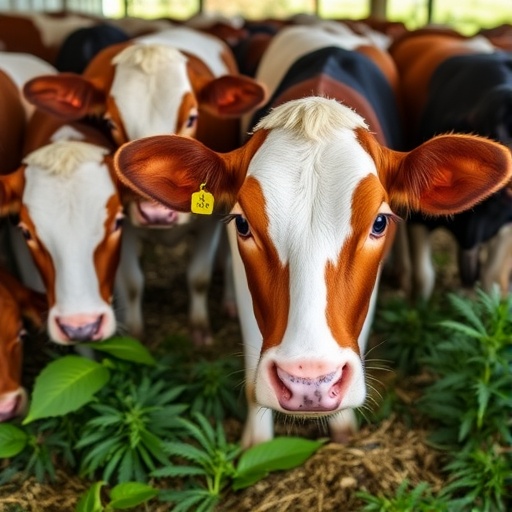In a groundbreaking experimental study conducted at Oregon State University, researchers have explored the implications of feeding spent hemp biomass to dairy cows, providing crucial insights into cannabinoid absorption, distribution, and clearance. This research addresses the pivotal concern surrounding the presence of Δ9-tetrahydrocannabinol (Δ9-THC), the psychoactive compound in hemp, and its potential transfer into milk and edible tissues, a pressing issue that has so far limited the commercial use of hemp byproducts as livestock feed.
The legalization of hemp cultivation in the United States in 2018 catalyzed a surge in industrial hemp production, particularly for cannabidiol (CBD) extraction, which accounts for more than 60% of hemp grown domestically. This extraction process results in a substantial amount of leftover plant material called spent hemp biomass. Despite its abundance, spent hemp biomass remains largely undervalued, primarily because the Food and Drug Administration (FDA) has yet to approve it for livestock consumption, worrying that residual THC might transfer to animal products and impact both animal welfare and human consumers.
Historically, hemp byproducts such as hemp seed and hempseed meal have been examined in previous studies, including those led by Massimo Bionaz and his colleagues, and found to be safe and nutritionally adequate for livestock such as cattle, lambs, and chickens. However, these studies did not comprehensively address the critical question of THC accumulation and clearance in dairy cows, nor did they evaluate the potential exposure risk to humans consuming milk from animals fed hemp byproducts.
The recent study set out with two core objectives: to quantify and understand the absorption, accumulation, and clearance kinetics of cannabinoids—including both CBD and Δ9-THC—in the milk and tissues of dairy cows, and to assess the human health risks associated with consuming milk from these cows. The research utilized a cohort of 18 Jersey cows, divided evenly between a treatment group consuming a diet containing 13% spent hemp biomass and a control group fed an equivalent diet featuring 13% alfalfa pellets in place of hemp residue.
Over a 28-day feeding period, the cows ingesting spent hemp biomass showed significant systemic absorption of cannabinoids. Analytical testing revealed the presence of cannabinoids in various biological matrices, including blood plasma, milk, and body tissues, underscoring the bioavailability of cannabinoids from hemp byproducts. Nonetheless, the pharmacokinetic analysis indicated a rapid clearance of cannabinoids from the cows’ systems once the hemp-containing diet was withdrawn.
Following the experimental feeding phase, all cows underwent a 28-day withdrawal period where their diet reverted to the control formulation without hemp biomass. Intriguingly, THC and other cannabinoid concentrations in milk and tissues dropped below detectable levels within approximately 15 days. This clearance timeline is critical, suggesting that a mandated withdrawal window before milking can effectively mitigate any risks of cannabinoid exposure to consumers.
The implications of these findings are profound for the hemp and dairy industries. For producers, the study offers a feasible pathway to repurpose spent hemp biomass—a byproduct currently regarded as waste—into a valuable feed supplement without compromising food safety or animal health. For regulatory agencies such as the FDA, these data provide the empirical foundation necessary for considering spent hemp biomass in feed approval processes, potentially catalyzing policy advancements that unlock new economic streams.
Moreover, the research contributes valuable toxicological insights. Δ9-THC exposure in humans typically hinges on dosage and route of administration, and unintended low-level intake through dairy products raises concerns about psychoactive effects. This study’s demonstration that careful dietary management can ensure THC levels in milk remain undetectable assuages public health fears and supports the consumer safety profile of dairy products.
Scientific methodology within this investigation was meticulous. The research team employed sensitive chromatographic techniques paired with mass spectrometry to measure cannabinoids with high specificity and sensitivity. Quantitative assessments allowed the researchers to draw robust conclusions about cannabinoid pharmacodynamics and overall distribution within the bovine system. This detailed approach strengthens the reliability of the results and underlines the rigor applied throughout the experimental procedures.
Additionally, this work sheds light on the metabolic pathways and clearance mechanisms in ruminants concerning cannabinoids, an area previously underexplored. Understanding these biological processes is crucial, as ruminant digestion features complex microbial interactions that could alter cannabinoid profiles and impact bioavailability differently than in monogastric species. The findings thus open new avenues for research regarding hemp-derived compounds in agricultural animal systems.
The broader context of this study situates it at the intersection of emerging agricultural innovations and regulatory science. As global markets for hemp continue to expand and diversify, establishing safe, evidence-based guidelines for the use of hemp byproducts in animal nutrition will become increasingly urgent. This study positions Oregon State University as a leader in this niche but vital field, contributing scientific clarity amidst evolving legislation and marketplace dynamics.
Looking forward, continued research is warranted to evaluate long-term feeding trials, potential effects on milk composition beyond cannabinoids, and investigations into other livestock species. Equally important will be socio-economic analyses exploring the impact of integrating hemp byproducts into conventional feed supply chains and assessing farmer uptake, consumer acceptance, and international trade implications.
In summary, the study presents a comprehensive, scientifically robust evaluation affirming that while cannabinoids from spent hemp biomass are absorbed by dairy cows, strategic withdrawal periods eliminate cannabinoid residues from milk, effectively neutralizing human consumer risk. This advancement not only supports the sustainable use of hemp cultivation residues but also brings us closer to regulatory acceptance and innovative agricultural practices that align economic viability with public health.
Subject of Research: Animals
Article Title: Cannabinoid Distribution and Clearance in Feeding Spent Hemp Biomass to Dairy Cows and the Potential Exposure to Δ9-THC by Consuming Milk
News Publication Date: 20-May-2025
Web References: 10.1021/acs.jafc.5c02827
References: Oregon State University study, Journal of Agricultural and Food Chemistry
Image Credits: Not provided
Keywords
Cannabinoids, Δ9-THC, Hemp Byproducts, Spent Hemp Biomass, Dairy Cows, Milk Safety, Livestock Feed, Hemp Legalization, Cannabinoid Clearance, Food Safety, Agricultural Innovation, Oregon State University




